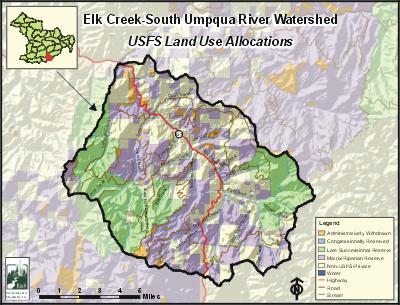 INSTITUTE FOR NATURAL RESOURCES
INSTITUTE FOR NATURAL RESOURCESYou are here
Watersheds
- Intro
- Planning Resources
- Research Projects
- Articles & Stories
- Maps & Tools
- Reports & Publications
- Data
- Photos & Videos
- More
Elk Creek-South Umpqua Watershed
Location and Size
The Elk Creek-South Umpqua fifth-field watershed is located in the southern portion of the Umpqua Basin. The watershed is 54,279 acres and includes all of the Elk Creek drainage. The watershed stretches a maximum of 12 miles north to south and 13 miles east to west.
Key Statistics
| Size (acres) | 54,279 |
| Percent public ownership | 64 |
| Miles of anadromous salmonid streams | 42 |
| Highest elevation (feet) | 4,900 |
| Lowest elevation (feet) | 1,000 |

E&S Environmental Chemistry
View large image
|
View as PDF
Landscape and Features
The Elk Creek-South Umpqua Watershed has fairly consistent high relief topography. Elevations range from 4,900 feet at Devils Knob on the eastern side of the watershed to 1,000 feet where Elk Creek meets the South Umpqua River. Other high-elevation areas include Hawk Mountain (4,780') and Timbered Rock (4,720'). Streams within the watershed deeply dissect the landscape.
Residents are scattered throughout the watershed, including in and around the community of Drew. The only major road within the watershed is the Tiller-Trail Highway (Douglas County Road #1). Various forest roads traverse the watershed.
Land ownership is primarily federal (64%), while private ownership occupies the balance (36%). Federal lands are administered by the Bureau of Land Management and U.S. Forest Service's Umpqua National Forest. Federal lands are managed as late successional reserve and matrix, mixed throughout the watershed. Late successional reserves are areas managed to protect and enhance conditions of late-successional and old-growth forest ecosystems. Matrix lands are those available for timber management at varying levels. Private lands are located along Elk Creek and checkerboarded throughout the watershed.
The most common land use in the Elk Creek-South Umpqua Watershed is forestry. Farming and ranching are common on the private bottomlands, including special use cattle allotments on the adjacent federal lands. Residential use is a minor component of the watershed.
Current Conditions
Cutthroat trout, coho salmon, winter steelhead, and spring chinook salmon are known to be present in the watershed. Pacific lamprey, western brook lamprey, speckled dace, Umpqua dace, Umpqua squawfish, Umpqua pikeminnow, sculpin species, redside shiner, and largescale sucker are found in the South Umpqua River above and below Elk Creek and are believed to use the habitat in Elk Creek.
As with many watersheds in southwestern Oregon, stream temperature limits water quality in much of the Elk Creek-South Umpqua Watershed. Within the watershed, Elk Creek and five of its tributaries are on the final 2002 303(d) list for summer stream temperature.
Approximately 35 percent of the federal riparian areas have been harvested or replaced by roadways. Timber salvage, hazard tree removal and stream clean out have occurred where roads allow access to the riparian area. The result is a lack of large woody debris in Elk Creek and across the lower reaches of the tributaries.
Much of Elk Creek and some of its tributaries have alternating areas of bedrock-dominated channel and deposition areas. Low levels of large woody debris do not exist to dampen high flows and trap bedload materials. Stream channels are constricted where roads are constructed in the flood plain. Aquatic habitat in the southern part of the watershed is limited in quality by naturally high levels of fine gravel and coarse sand.
Water withdrawals within the watershed appropriate all natural flow during the summer months. Additional water rights are not available.
Sources
ODEQ 303(d) list: http://www.deq.state.or.us/wq/assessment/rpt02/gis02.zip. Accessed on-line on January 13, 2006.
Umpqua Basin Watershed Council Assessment: Tiller Region Assessment and Action Plan, Umpqua Basin Watershed Council, November 2003.
US Forest Service Watershed Analysis: Elk Creek Watershed Analysis, Tiller Ranger District, Umpqua National Forest, October 1996.










